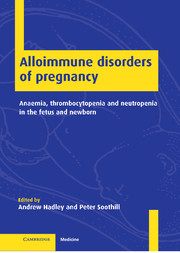 Alloimmune Disorders of Pregnancy
Alloimmune Disorders of Pregnancy Book contents
- Frontmatter
- Contents
- List of contributors
- Preface
- Foreword
- List of abbreviations
- 1 Pathophysiology of the alloimmune cytopenias
- 2 Blood group antibodies in haemolytic disease of the fetus and newborn
- 3 Basis and practice of screening for haemolytic disease of the fetus and newborn
- 4 Epidemiology and screening for alloimmune thrombocytopenia
- 5 Principles of antibody-mediated immune suppression and the prevention of maternal RhD alloimmunization
- 6 The clinical application of anti-D prophylaxis
- 7 Fetal genotyping
- 8 Laboratory assays to determine the severity of haemolytic disease of the fetus and newborn
- 9 Assessing the severity of haemolytic disease of the fetus and newborn: clinical aspects
- 10 Antenatal therapy for haemolytic disease of the fetus and newborn
- 11 Neonatal therapy for haemolytic disease of the newborn
- 12 The diagnosis of alloimmune thrombocytopenia
- 13 The immunological diagnosis of alloimmune neutropenia
- 14 Fetal and neonatal treatment of alloimmune thrombocytopenia
- Index
1 - Pathophysiology of the alloimmune cytopenias
Published online by Cambridge University Press: 26 October 2009
- Frontmatter
- Contents
- List of contributors
- Preface
- Foreword
- List of abbreviations
- 1 Pathophysiology of the alloimmune cytopenias
- 2 Blood group antibodies in haemolytic disease of the fetus and newborn
- 3 Basis and practice of screening for haemolytic disease of the fetus and newborn
- 4 Epidemiology and screening for alloimmune thrombocytopenia
- 5 Principles of antibody-mediated immune suppression and the prevention of maternal RhD alloimmunization
- 6 The clinical application of anti-D prophylaxis
- 7 Fetal genotyping
- 8 Laboratory assays to determine the severity of haemolytic disease of the fetus and newborn
- 9 Assessing the severity of haemolytic disease of the fetus and newborn: clinical aspects
- 10 Antenatal therapy for haemolytic disease of the fetus and newborn
- 11 Neonatal therapy for haemolytic disease of the newborn
- 12 The diagnosis of alloimmune thrombocytopenia
- 13 The immunological diagnosis of alloimmune neutropenia
- 14 Fetal and neonatal treatment of alloimmune thrombocytopenia
- Index
Summary
The pathogenesis of the alloimmune cytopenias can be considered in four stages: alloimmunization of the mother, the placental transfer of antibodies to a fetus, the immune destruction of sensitized blood cells and, finally, clinical manifestations which are secondary to the destruction of fetal blood cells such as hydrops, haemorrhage or infection.
Maternal Alloimmunization
Some key events in the humoral immune response
A comprehensive review of humoral immune responses is outside the scope of this chapter. Nevertheless, a brief consideration of the cells and some of the key processes which result in the production of antibodies is pertinent to several topics covered in this book such as the genetic predisposition to form certain alloantibodies (Section 1.1.3), the mode of action of Rh prophylaxis (Section 5.5), and the basis of new approaches to ameliorate maternal alloimmune responses (Section 14.5). These key steps are shown diagrammatically in Figure 1.1.
Two phases of an immune response are distinguished. The primary response results in very low or undetectable levels of circulating antibody. The second anamnestic response is characterized by much higher concentrations of antibody. The immune response starts with the nonspecific uptake of an antigen by antigenpresenting cells in lymphoid centres such as the spleen and lymph nodes. Internalized antigens are then incorporated into phagolysosomes where they are partially degraded by proteolytic enzymes to peptide fragments. The peptides then associate with HLA class II molecules before being returned to the cell surface and so ‘presented’ to helper T cells.
- Type
- Chapter
- Information
- Alloimmune Disorders of PregnancyAnaemia, Thrombocytopenia and Neutropenia in the Fetus and Newborn, pp. 1 - 20Publisher: Cambridge University PressPrint publication year: 2001


